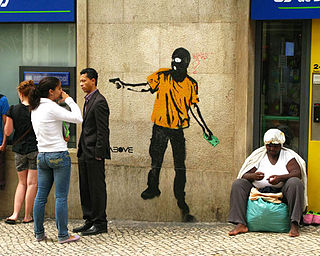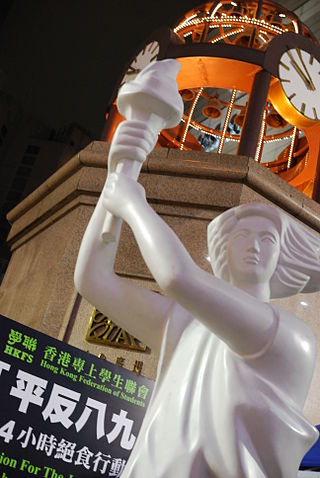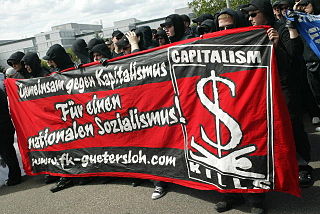Related Research Articles

A protest is a public act of objection, disapproval or dissent against political advantage. Protests can be thought of as acts of cooperation in which numerous people cooperate by attending, and share the potential costs and risks of doing so. Protests can take many different forms, from individual statements to mass political demonstrations. Protesters may organize a protest as a way of publicly making their opinions heard in an attempt to influence public opinion or government policy, or they may undertake direct action in an attempt to enact desired changes themselves. When protests are part of a systematic and peaceful nonviolent campaign to achieve a particular objective, and involve the use of pressure as well as persuasion, they go beyond mere protest and may be better described as civil resistance or nonviolent resistance.

Student activism or campus activism is work by students to cause political, environmental, economic, or social change. In addition to education, student groups often play central roles in democratization and winning civil rights.

Youth activism is the participation in community organizing for social change by persons between the ages of 15–24. Youth activism has led to a shift in political participation and activism. A notable shift within youth activism is the rise of “Alter-Activism” resulting in an emphasis on lived experiences and connectivity amongst young activists. The young activists have taken lead roles in public protest and advocacy around many issues like climate change, abortion rights and gun violence.
Internet activism involves the use of electronic-communication technologies such as social media, e-mail, and podcasts for various forms of activism to enable faster and more effective communication by citizen movements, the delivery of particular information to large and specific audiences, as well as coordination. Internet technologies are used by activists for cause-related fundraising, community building, lobbying, and organizing. A digital-activism campaign is "an organized public effort, making collective claims on a target authority, in which civic initiators or supporters use digital media." Research has started to address specifically how activist/advocacy groups in the U.S. and in Canada use social media to achieve digital-activism objectives.

Protest art is the creative works produced by activists and social movements. It is a traditional means of communication, utilized by a cross section of collectives and the state to inform and persuade citizens. Protest art helps arouse base emotions in their audiences, and in return may increase the climate of tension and create new opportunities to dissent. Since art, unlike other forms of dissent, takes few financial resources, less financially able groups and parties can rely more on performance art and street art as an affordable tactic.

Artivism is a portmanteau word combining art and activism, and is sometimes also referred to as Social Artivism.

A political demonstration is an action by a mass group or collection of groups of people in favor of a political or other cause or people partaking in a protest against a cause of concern; it often consists of walking in a mass march formation and either beginning with or meeting at a designated endpoint, or rally, in order to hear speakers. It is different from mass meeting.
Mass mobilization refers to mobilization of civilian population as part of contentious politics. Mass mobilization is defined as a process that engages and motivates a wide range of partners and allies at national and local levels to raise awareness of and demand for a particular development objective through face-to-face dialogue. Members of institutions, community networks, civic and religious groups and others work in a coordinated way to reach specific groups of people for dialogue with planned messages. In other words, social mobilization seeks to facilitate change through a range of players engaged in interrelated and complementary efforts.

Angola has long been severely criticized for its human rights record. A 2012 report by the U.S. Department of State said, "The three most important human rights abuses [in 2012] were official corruption and impunity; limits on the freedoms of assembly, association, speech, and press; and cruel and excessive punishment, including reported cases of torture and beatings as well as unlawful killings by police and other security personnel. Other human rights abuses included: harsh and potentially life-threatening prison conditions; arbitrary arrest and detention; lengthy pretrial detention; impunity for human rights abusers; lack of judicial process and judicial inefficiency; infringements on citizens' privacy rights and forced evictions without compensation; restrictions on nongovernmental organizations; discrimination and violence against women; abuse of children; trafficking in persons; discrimination against persons with disabilities, indigenous people, and persons with HIV/AIDS; limits on workers' rights; and forced labor." In 2022, Freedom House rated Angola "not free".

In the days following the end of the 1989 Tiananmen Square protests and massacre, several memorials and vigils were held around the world for those who were killed in the demonstrations. Since then, annual memorials have been held in places outside of mainland China, most notably in Hong Kong, Taiwan and the United States.

Autonome Nationalisten are German, British, Dutch, and to a lesser degree Flemish, nationalists, who have adopted some of the far-left and antifa's organizational concepts, demonstration tactics, symbolism, and elements of clothing, including Che Guevara T-shirts and keffiyehs. Similar groups have also appeared in some central and eastern European countries, beginning with Poland, the Czech Republic, Ukraine, Romania and Greece and others.

The 1962 Rangoon University protests, also known as the 7 July Student Uprising, were a series of marches, demonstrations, and protests against stricter campus regulations, the end of the system of university self-administration, and the policy of the new military regime of General Ne Win. The main events took place in Rangoon, Burma, from 7 to 8 July 1962. On 7 July the military regime violently suppressed a student demonstration at Rangoon University attended by some 5,000 students. This resulted in the deaths of more than one hundred, and the arrest of more than 6,000 students according to unofficial sources. However, official government statements put the death toll at 15. In the morning hours of the next day, the military regime blew up the historic Rangoon University Students' Union (RUSU) building, which had been the symbol of the anti-colonial nationalism struggle since the 1920s.
Online social movements are organized efforts to push for a particular goal through the use of new communications and information technologies, such as the Internet. In many cases, these movements seek to counter the mainstream public, claiming there is a wrong that should be righted. Online social movements have focused on a broad range on social and political issues in countries all around the world.
Fashion activism is the practice of using fashion as a medium for social, political, and environmental change. The term has been used recurringly in the works of designers and scholars Lynda Grose, Kate Fletcher, Mathilda Tham, Kirsi Niinimäki, Anja-Lisa Hirscher, Zoe Romano, and Orsola de Castro, as they refer to systemic social and political change through the means of fashion. It is also a term used by some fashion designers, one being Stella McCartney. The spectacle of fashion activism as street protest has also been a theme in Paris Catwalk shows. The term is used by Céline Semaan, co-founder of the Slow Factory Foundation.

The Hirak Rif Movement or the Rif Movement is a popular resistance movement that organised mass protests in the Berber Rif region in northern Morocco between October 2016 and June 2017. The movement was triggered by the death of Mouhcine Fikri, a fishmonger who was crushed to death after jumping in the back of a garbage truck attempting to retrieve his allegedly illegal fish merchandise confiscated by local authorities.

Socio-political activism to raise awareness about HIV/AIDS as well as to advance the effective treatment and care of people with AIDS (PWAs) has taken place in multiple locations since the 1980s. The evolution of the disease's progress into what's known as the HIV/AIDS pandemic has resulted in various social movements fighting to change both government policies and the broader popular culture inside of different areas. These groups have interacted in a complex fashion with others engaged in related forms of social justice campaigning, with this continuing on to this day.
Internet activism in South Korea originated in 2002, when an Internet user named Angma proposed a candlelight vigil for two girls who were killed by a U.S. military vehicle in the Yangju highway incident. Angma's post circulated widely online, mobilizing ordinary people to demand SOFA reform and an apology from President George W. Bush with peaceful candlelight protests in Kwanghwamun. Since then, the Internet has been a space for open discussion of sociopolitical issues and grassroots activism in South Korea. Other examples of Internet activism in Korea are the 2008 U.S. beef protest, anti-Chosunilbo protests, and online feminist and LGBTQ movements with hashtags.

Following the Sewol Ferry sinking on 16 April 2014, yellow ribbons became a prevalent symbol in South Korea, its significance evolving from hopes of return and mourning to activism and democratization. Historically, yellow colored ribbons were used as a symbol of support for military troops in Western countries including the U.S., Canada, Germany, Sweden, and Denmark, its usage mainly signifying hopes of someone's safe return. During the 1980s, the yellow ribbons were adopted in the Philippines as a symbol of democratization, which inspired South Korea to use the symbol for democratization as well. When the Sewol Ferry capsized off South Korea's southern coast near Jindo County on 16 April 2014, the yellow ribbon quickly became a widespread symbol online symbolizing hopes of return of the passengers. However, once it became clear that the victims would not be coming back, citizens began questioning the competency of the government. The significance of the yellow ribbon evolved from symbolizing public remembrance and sympathy to defiance against the government, activism and protest culture, and democratization. As a result of the apolitical symbol's transformation into a political one, the color yellow quickly became a topic of contention. Regardless, tiny yellow ribbons circulated widely all over South Korea, both virtually through social media and physically through portable items and at significant sites. Yellow ribbons, in tandem with other yellow-colored items, came to define spaces of protest and political resistance among progressive activists in South Korea.

Figo Chan Ho-wun is a Hong Kong pro-democracy activist who served as convener of the Civil Human Rights Front from October 2020 until his conviction in May 2021, when he was succeeded by Chung Chung-fai. As vice-convener of the organisation Chan and then convener Jimmy Sham Tsz-kit, planned major marches during the 2019–20 Hong Kong protests. In November 2019, Chan and Emily Lau were awarded the John McCain Prize for Leadership in Public Service on behalf of the people of Hong Kong during the Halifax International Security Forum. He also is member of the League of Social Democrats.

Blank pieces of paper, posters and placards have been used as a form of protest. The message sent by such a protest is meant to be implicit and understood, but the lack of writing and slogans on the paper itself is designed to thwart efforts by authorities to prove that their prohibitions and regulations have been violated.
References
- 1 2 3 4 5 6 7 8 9 "Peopleless Protest: Bridging the Online-Offline Divide for Greater Movement Impact in the COVID-19 Period". International Center on Nonviolent Conflict. 2020-08-26. Retrieved 2023-07-17.
- 1 2 3 4 5 "Peopleless Protest: Standing up for Refugee Rights Despite the Lockdown". Reset. 2020-04-17. Retrieved 2023-07-17.
- 1 2 "The Power of Peaceful Protests". Vision of Humanity. 2020-06-24. Retrieved 2023-07-17.
- 1 2 "Protest Movements: How Effective are They?". The Commons. 2020-09-15. Retrieved 2023-07-17.
- 1 2 Rohlinger, D. A.; Meyer, D. S. (2022-10-25). "Protest During a Pandemic: How Covid-19 Affected Social Movements". The American Behavioral Scientist. doi:10.1177/00027642221132179. PMC 9596683 .
- 1 2 "Myanmar's Spring Revolution". ACLED. 2021-09-01. Retrieved 2023-07-17.
- ↑ "Do Protests Even Work?". The Atlantic. 2020-06-24. Retrieved 2023-07-17.